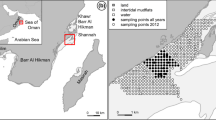Abstract
The aim of this work was to determine the abundance of crabs inmangrove communities along a latitudinal gradient along the eastern coastof Africa from 4°S to 32°S. Surveys were made atMombasa (Kenya), Zanzibar (Tanzania), Maputo (Mozambique) and in theTranskei (South Africa). Crabs were estimated at three designated levelsin the mangroves by visual census using a common protocol, and numberswere converted to biomass.Even after standardising the selection of sites and methods of censusthere was still extensive variability in the data, emphasising the complexheterogeneity of mangrove ecosystems. Lunar phase (full versus new moonsprings) did not have a consistent effect on results, but shore height hadseveral effects. Total crab biomass was similar in the two lower shore strataexamined, but about twice as high at the top-Avicennia level. Theratio of grapsid biomass:ocypodid biomass also changed with height: fromnear unity in the lower mangrove, to 0.14 in the middle strata, but to 15at the top.There was no consistent latitudinal trend in total crab numbers, but totalcrab biomass increased from north to south. In addition there was aconsistent and marked change in the grapsid biomass:ocypodid biomassratio: this swung from 0.65 at Mombasa to 6.8 in the Transkei. This hasimplications for the transfer of primary production through the food chain. Grapsids are important macrophagous feeders on the leaves and other partsof mangroves, whereas ocypodids are microphagous deposit feeders.
Similar content being viewed by others
References
Cannicci, S., Dahdouh-Guebas, F., Anyona, D. and Vannini, M. 1996. Natural diet and feeding habits of Thalamita crenata (Decapoda: Portunidae). J. Crust. Biol. 16: 678–683.
Cannicci, S., Ruwa, R.K., Giuggioli, M. and Vannini, M. 1998. Predatory activity and spatial strategies of Epixanthus dentatus (Decapoda, Oziidae): an ambush predator among the mangroves. J. Crust. Biol. 18: 57–63.
Cannicci, S., Fratini, S. and Vannini, M. 1999. Use of time, space and food resources in the mangrove climbing crab Selatium elongatum (Grapsidae: Sesarminae). Marine Biol. 135: 335–339.
Crane, J. 1975. Fiddler Crabs of the World. Ocypodidae: Genus Uca. Princeton University Press, Princeton, New Jersey, USA. 736 pp.
Derijard, R. 1966. Contribution à l'étude du peuplement des sédiments sablo-vaseux et vaseux intertidaux compactés ou fixés par la vegetation de la region de Tulear. Études Malagaches 17: 1–94.
Emmerson, W.D. and McGwynne, L.E. 1992. Feeding and assimilation of mangrove leaves by the crab Sesarma meinerti de Man in relation to leaf litter production in Mgazana, a warm temperate southern African mangrove swamp. J. Exp. Marine Biol. Ecol. 157: 41–53.
Fratini, S., Cannicci, S., Abincha, L.M. and Vannini, M. 2000. Feeding, temporal and spatial preferences of Metopograpsus thukuhar (Decapoda: Grapsidae): an opportunistic mangrove dweller. J. Crust. Biol. 20: 326–333.
Giddins, R.L., Lucas, J.S., Neilson, M.J. and Richards, G.N. 1986. Feeding ecology of the mangrove crab Neosarmatium smithi (Crustacea: Decapoda: Sesarmidae). Marine Ecol. – Prog. Ser. 33: 147–155.
Hartnoll, R.G. 1975. The Grapsidae and Ocypodidae (Decapoda, Brachyura) of Tanzania. J. Zool. 177: 305–328.
Hartnoll, R.G. 1988. The eco-ethology of mangroves. In: Chelazzi, G. and Vannini, M. (eds.), Behavioural Adaptations to Intertidal Life, NATO ASI Series, Series A, Vol. 151: pp. 477–489, Plenum Press, New York.
Holme, N.A. and McIntyre, A.D. (eds.), 1971. IBP Handbook No. 16. Methods for the Study of Marine Benthos. Blackwell Scientific Publications, Oxford, UK. 334 pp.
Icely, J.D. and Jones, D.A. 1978. Factors affecting the distribution of the genus Uca (Crustacea: Ocypodidae) on an East African shore. Est. Coast. Marine Sci. 6: 315–325.
Kalk, M. (ed.), 1995. A Natural History of Inhaca Island. Witwatersrand University Press, Johannesburg, South Africa. 395 pp.
Keenan, C.P. and Blackshaw, A. 1999. Mud crab aquaculture and biology. ACIAR Proc. 78: 1–216.
Lee, S.Y. 1997. Potential trophic importance of the faecal material of the mangrove sesarmine crab Sesarma messa. Marine Ecol. Prog. Ser. 159: 275–284.
Lee, S.Y. 1998. Ecological role of grapsid crabs in mangrove ecosystems: a review. Marine Freshw. Res. 49: 335–343.
Macintosh, D.J. 1984. Ecology and productivity of Malaysian mangrove crab populations (Decapoda: Brachyura). In: Soepadmo, E., Rao, A.N. and Macintosh, D.J. (eds.), Proceedings of the Asian Symposium on Mangrove Environment, Research and Management, pp. 354–377. Kuala Lumpur, 1984. University of Malaya and UNESCO.
Macnae, W. 1968. A general account of the fauna and flora of man-grove swamps and forests in the Indo-west-Pacific region. Adv. Marine Biol. 6: 73–270.
Macnae, W. and Kalk, M. 1962. The ecology of the mangrove swamps at Inhaca Island, Mocambique. J. Ecol. 50: 19–34.
McIvor, C.C. and Smith, T.J. III. 1995. Differences in the crab fauna of mangrove areas of southwest Florida and a northeast Australia location: implications for leaf litter processing. Estuaries 18: 591–597.
Micheli, F. 1993. Effect of mangrove litter species and availability on survival, moulting, and reproduction of the mangrove crab Sesarma messa. J. Exp. Marine Biol. Ecol. 171: 149–163.
Micheli, F., Gherardi, F. and Vannini, M. 1991. Feeding and burrowing ecology of two East African mangrove crabs. Marine Biol. 111: 247–254.
Robertson, A.I. and Daniel, P.A. 1989. The influence of crabs on litter processing in high intertidal mangrove forests in tropical Australia. Oecologia 78: 191–198.
Skov, M.W. and Hartnoll, R.G. 2001. Comparative suitability of binocular observation, burrow counting and excavation for the quantification of the mangrove fiddler crab Uca annulipes (H. Milne Edwards). Hydrobiologia 449: 201–222.
Skov, M.W. and Hartnoll, R.G. 2002. Paradoxical selective feeding on a low nutrient diet. Why do mangrove crabs eat leaves? Oecologia 131: 1–7.
Vannini, M. and Ruwa, R.K. 1994. Vertical migrations in the tree crab Sesarma leptosoma (Decapoda, Grapsidae). Marine Biol. 118: 271–278.
Author information
Authors and Affiliations
Rights and permissions
About this article
Cite this article
Hartnoll, R., Cannici, S., Emmerson, W. et al. Geographic trends in mangrove crab abundance in East Africa. Wetlands Ecology and Management 10, 203–213 (2002). https://doi.org/10.1023/A:1020123713133
Issue Date:
DOI: https://doi.org/10.1023/A:1020123713133




